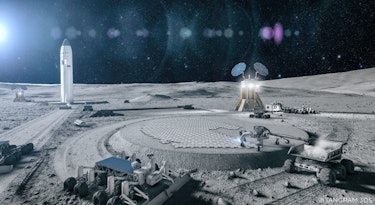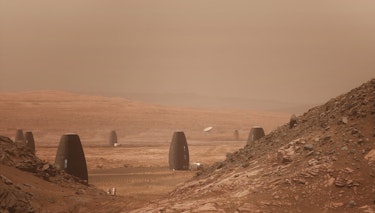Architecture plays a critical role in supporting the exploration of the Moon and Mars. With a growing interest in space exploration, architecture firms are designing habitats, building infrastructure, developing sustainable systems, and planning mission logistics for human exploration of these planets.
One of the most significant challenges for human exploration of the Moon and Mars is the harsh environmental conditions. These planets have extreme temperatures, radiation, and dust storms, which means that habitats and infrastructure need to be designed to withstand these conditions. Architects are working on designing structures that can be easily transported and assembled on these planets. These structures need to be modular and adaptable, able to be reconfigured as needed to meet the demands of exploration missions.
3D visualisation is another critical aspect of architecture in supporting the exploration of the Moon and Mars. 3D visualisation technology allows architects to create realistic and detailed digital models of habitats, infrastructure, and equipment for space exploration missions. These 3D models can be used to communicate design concepts to stakeholders, identify potential problems or challenges, and visualize the final product before construction begins.

Credit: ArchDaily
Habitats are one of the most crucial components of any exploration mission. They provide shelter, protection from the elements, and a safe environment for astronauts to live and work in. Architecture firms are designing habitats that can support long-term human presence on the Moon and Mars. These habitats need to be able to operate in extreme conditions and be self-sustaining, with systems for water recycling, waste management, and food production. Architects are also working on designing habitats that can be easily expanded and adapted as exploration missions continue to evolve.
Building infrastructure is another critical aspect of supporting exploration missions. Infrastructure includes landing pads for spacecraft, roads, and power systems. Architects are designing landing pads that can accommodate a variety of spacecraft and provide a safe landing environment. They are also working on designing roads and transportation systems that can transport astronauts and equipment across the surface of these planets.

Credit: ArchDaily
Power systems are another essential component of infrastructure. Architects are working on designing solar arrays and other power systems that can provide a reliable source of energy in the harsh environmental conditions of the Moon and Mars. These power systems need to be able to operate in low light conditions, as well as provide enough energy to support the needs of the habitat and infrastructure.
Sustainable systems are also critical to supporting long-term human exploration of the Moon and Mars. Architects are working on designing systems for water recycling, waste management, and food production. Water is a precious resource on these planets, so architects are designing systems that can recycle and reuse water. Waste management is also essential, with architects designing systems that can dispose of waste safely and effectively. Food production is another critical component of sustainable systems, with architects designing systems that can provide fresh food for astronauts to eat.
Planning mission logistics is another crucial aspect of supporting exploration missions. Architects are designing spacecraft interiors to optimize space and minimize weight. They are also designing cargo storage systems that can transport equipment and supplies to and from the Moon and Mars. Planning logistics for exploration missions is complex, and architects need to consider factors such as the weight of equipment and supplies, as well as the needs of the astronauts.

Credit: ESA
3D visualisation technology is also used in the development of virtual reality simulations, which can help astronauts prepare for space exploration missions. These simulations allow astronauts to experience the environment of the Moon and Mars, providing a realistic and immersive training experience. This technology is essential for preparing astronauts for the challenges of living and working in space, as well as for testing and refining design concepts before construction begins.
Another use of 3D visualisation in space exploration is in the development of robotic systems. Robots are becoming increasingly important for space exploration, as they can perform tasks that are too dangerous or difficult for humans. 3D visualisation technology allows architects to create detailed digital models of these robotic systems, allowing engineers to test and refine their design concepts before construction begins.
In addition to supporting the exploration of the Moon and Mars, 3D visualisation technology is also used in space architecture on Earth. For example, architects are using 3D visualisation technology to design and plan the construction of space stations and other structures in low Earth orbit. This technology allows architects to create detailed digital models of these structures, allowing engineers to test and refine design concepts before construction begins.

Credit: The Architect’s Newspaper
In conclusion, architecture plays a critical role in supporting the exploration of the Moon and Mars. By designing habitats, building infrastructure, developing sustainable systems, and planning mission logistics, architects are helping to make human exploration of these planets possible. With a growing interest in space exploration, architects will continue to play a critical role in shaping the future of space exploration. By allowing architects to create detailed digital models of habitats, infrastructure, equipment, and robotic systems, 3D visualisation technology is helping to make space exploration missions more efficient and effective. This technology is also essential for preparing astronauts for the challenges of living and working in space and for testing and refining design concepts before construction begins.
.jpg?ixlib=gatsbyFP&auto=compress%2Cformat&fit=max&q=75&w=375)